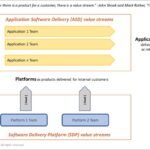This article was originally written as a contribution to a collective post for the VSM Consortium blog (find the full article using the link below):
https://www.vsmconsortium.org/blog/is-release-management-a-value-stream (May 4, 2022)
–
“In this, the second of a series of blog posts from the Value Stream Management Consortium, our experts weigh in on, “Is THIS a value stream?” This time, we’re looking at Release Management.”
Patrice Corbard, Founder of SD ReFocus and Influencer Member of the Value Stream Management Consortium:
No, I think Release Management is a discipline that is integrated or supports the software delivery value streams.
The term “release” can be used in different ways, which can be confusing:
- A “release” as the software product or service delivered to users;
- A “release” as a step, process or activity in our SDLC (software delivery lifecycle);
- A “release” as a phase of the DevOps infinite loop aiming to prepare the software before its deployment in production;
- A “release” as the action of making the software available to users, after it has been technically deployed to production.
In this type of situation, it is important to start by sharing a common vocabulary and adopting naming conventions to facilitate our understanding.
First, my preference is to use the term “release” or “software release” to designate the product or service as defined by the ISO/IEC 20000 standard definition:
A release is a collection of one or more new or changed services or service components deployed into the live environment as a result of one or more changes.
–
Then, when we visualise the existing or desired flow of work on a Value Stream Map, we represent the “release” as a product and use an “action verb-noun” format to clearly identify macro activities or processes like for instance “prepare the release”, “deploy the release”, or “open the release to end users” :

–
The software delivery value stream is supported by activities of the release management discipline, from release planning to delivery and user feedback loops. In other words, the software delivery value stream includes activities or processes, roles, artefacts, automation, … from this release management discipline.
In complex situations where there are many dependencies (although ideally we should strive to reduce or eliminate these dependencies), release management activities may be necessary to orchestrate the delivery of a release by integrating the components or products of several “stream-aligned teams” as defined in the book “Team Topologies”.
–
Picture by Ankush Minda on Unsplash

